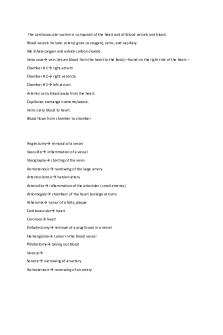Renin angiotensin aldosterone system PDF

| Title | Renin angiotensin aldosterone system |
|---|---|
| Author | Sandra Jepkemoi KIPRUTO |
| Course | Clinical Science 3 |
| Institution | Edith Cowan University |
| Pages | 4 |
| File Size | 137.9 KB |
| File Type | |
| Total Downloads | 14 |
| Total Views | 131 |
Summary
Renin angiotensin aldosterone system...
Description
CONCEPT MAP
Assignment Title: Renin-Angiotensin Aldosterone system and its association with hypertension Unit title: NSC1103D Clinical Sciences Introduction Lecturer: Eric Adua Student Name: Sandra Jepkemoi Kipruto Student Number: 60052407 Submission date: 17th December 2020 Word Count: 512
The renin-angiotensin-aldosterone system also known as (RAAS) is one of the most prime hormonal systems in running hemodynamic homeostasis through balancing pressure level of blood, volume of fluid, and the balance of sodium and potassium (Munoz-Durango et al., 2016). The renin angiotensin system not only comprises of renin, angiotensin 2 and aldosterone hormone but is also controlled by the frequency of renal blood flow. Elevated levels of aldosterone (controls sodium and potassium levels) and angiotensin II are factors that cause high pressure levels therefore leading to hypertension (Liu et al., 2020). Normally, when the body’s blood pressure is low, the juxtaglomerular cell in the kidney would be triggered to convert prorenin to renin and release it. Other forms of triggers are low salt in the distal convoluted tubule and sympathetic nerve cells. The macula densa cells which are located in the distal convoluted tubule of the nephron are able to sense sodium. In circulation, renin breaks down angiotensinogen which is found in the liver, forming angiotensin I (Kafoury, 2015). Angiotensin I is changed into to angiotensin II by the angiotensin converting enzyme (ACE), which is found in the lungs. Angiotensin II has an effect two receptors, the angiotensin type 1 and type 2 receptors (Ames et al., 2019. According to Marieb and Hoehn, 2020, angiotensin II acts in two ways to bring back the blood pressure to normal. The first way is through secreting aldosterone hormone in the adrenal gland. As a result, sodium and water undergo reabsorption into the blood stream to increase blood volume. The second way is through the release of anti-diuretic hormone by the posterior pituitary gland which again makes the kidney reabsorb water. This further activates the sensation of feeling thirsty and therefore increases water consumption and blood pressure. Lastly, Anti-diuretic hormone (efficient vasoconstrictor) increases blood pressure through increasing surrounding resistance. Even though the Renal Angiotensin Antidiuretic system plays an important function in maintaining blood pressure, there are other cases where it can be inappropriately triggered. These conditions may then result to the occurrence of abnormally high blood pressure. In particular, the renal artery narrows abnormally and further results in less volume of blood going in to the kidneys. Consequently, this makes the juxtaglomerular cells (JGC) sense a deviant decrease in volume of blood, triggering the Renal Antidiuretic Aldosterone system. This brings about an irrelevant increase of circulating volume of blood and arteriolar tone as a result of poor renal perfusion (Fountain and Lappin, 2020). The processes identified are summarized in the concept map below.
References Ames, M. K., Atkins, C. E., & Pitt, B. (2019). The renin-angiotensin-aldosterone system and its suppression. Journal of veterinary internal medicine, 33(2), 363–382. https://doi.org/10.1111/jvim.15454 Fountain J.,H. Lappin S.,L. (2020). Physiology, Renin Angiotensin System. StatPearls Publishing Liu, Y., Lin, Y., Zhang, MM. et al. (2020), The relationship of plasma renin, angiotensin, and aldosterone levels to blood pressure variability and target organ damage in children with essential hypertension. BMC Cardiovasc Disord 20(296). https://doi.org/10.1186/s12872-020-01579-x Maricica Pacurari, Ramzi Kafoury, Paul B. Tchounwou, Kenneth Ndebele. (2015). The Renin-Angiotensin-Aldosterone System in Vascular Inflammation and Remodeling, International Journal of Inflammation. https://doi.org/10.1155/2014/689360 Marieb, N.,E. Hoehn, Katja. (2020). Human Anatomy and Psychology. Cenveo Publisher Services Muñoz-Durango, N., Fuentes, C. A., Castillo, A. E., González-Gómez, L. M., Vecchiola, A., Fardella, C. E., & Kalergis, A. M. (2016). Role of the Renin-Angiotensin-Aldosterone System beyond Blood Pressure Regulation: Molecular and Cellular Mechanisms Involved in End-Organ Damage during Arterial Hypertension. International journal of molecular sciences, 17(7), 797. https://doi.org/10.3390/ijms17070797...
Similar Free PDFs

ARBs (ACE/Renin Blockers)
- 6 Pages

Lymphatic System & Immune System
- 6 Pages

information system
- 5 Pages

Cardiovascular system
- 2 Pages

CIRCULATORY SYSTEM
- 12 Pages

Integumentary System
- 11 Pages

System - gggggggggggggggggg
- 1 Pages

Respiratory system
- 8 Pages

Cardiovascular System
- 2 Pages

ROTARY SYSTEM
- 18 Pages

Coding System
- 4 Pages

System Disorder
- 1 Pages
Popular Institutions
- Tinajero National High School - Annex
- Politeknik Caltex Riau
- Yokohama City University
- SGT University
- University of Al-Qadisiyah
- Divine Word College of Vigan
- Techniek College Rotterdam
- Universidade de Santiago
- Universiti Teknologi MARA Cawangan Johor Kampus Pasir Gudang
- Poltekkes Kemenkes Yogyakarta
- Baguio City National High School
- Colegio san marcos
- preparatoria uno
- Centro de Bachillerato Tecnológico Industrial y de Servicios No. 107
- Dalian Maritime University
- Quang Trung Secondary School
- Colegio Tecnológico en Informática
- Corporación Regional de Educación Superior
- Grupo CEDVA
- Dar Al Uloom University
- Centro de Estudios Preuniversitarios de la Universidad Nacional de Ingeniería
- 上智大学
- Aakash International School, Nuna Majara
- San Felipe Neri Catholic School
- Kang Chiao International School - New Taipei City
- Misamis Occidental National High School
- Institución Educativa Escuela Normal Juan Ladrilleros
- Kolehiyo ng Pantukan
- Batanes State College
- Instituto Continental
- Sekolah Menengah Kejuruan Kesehatan Kaltara (Tarakan)
- Colegio de La Inmaculada Concepcion - Cebu



